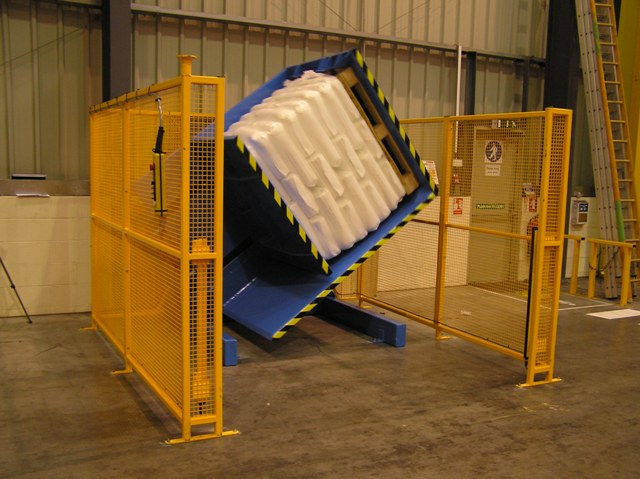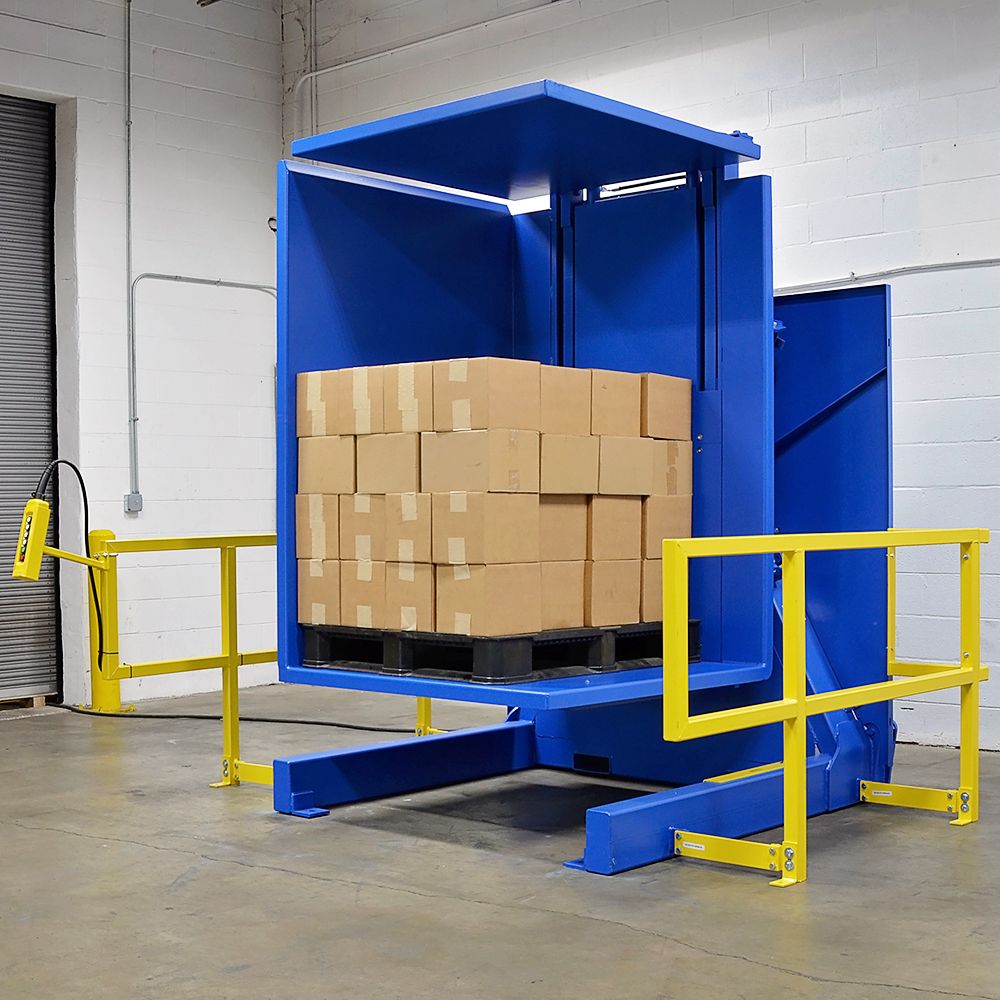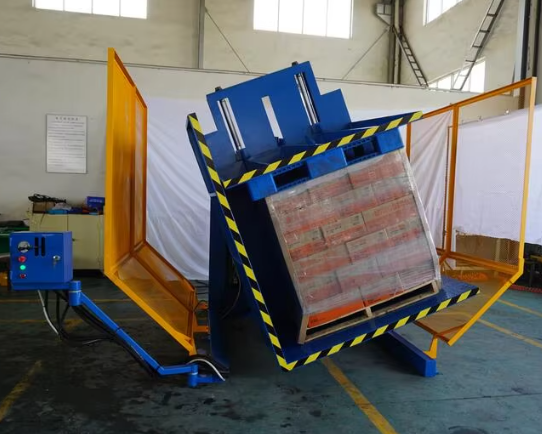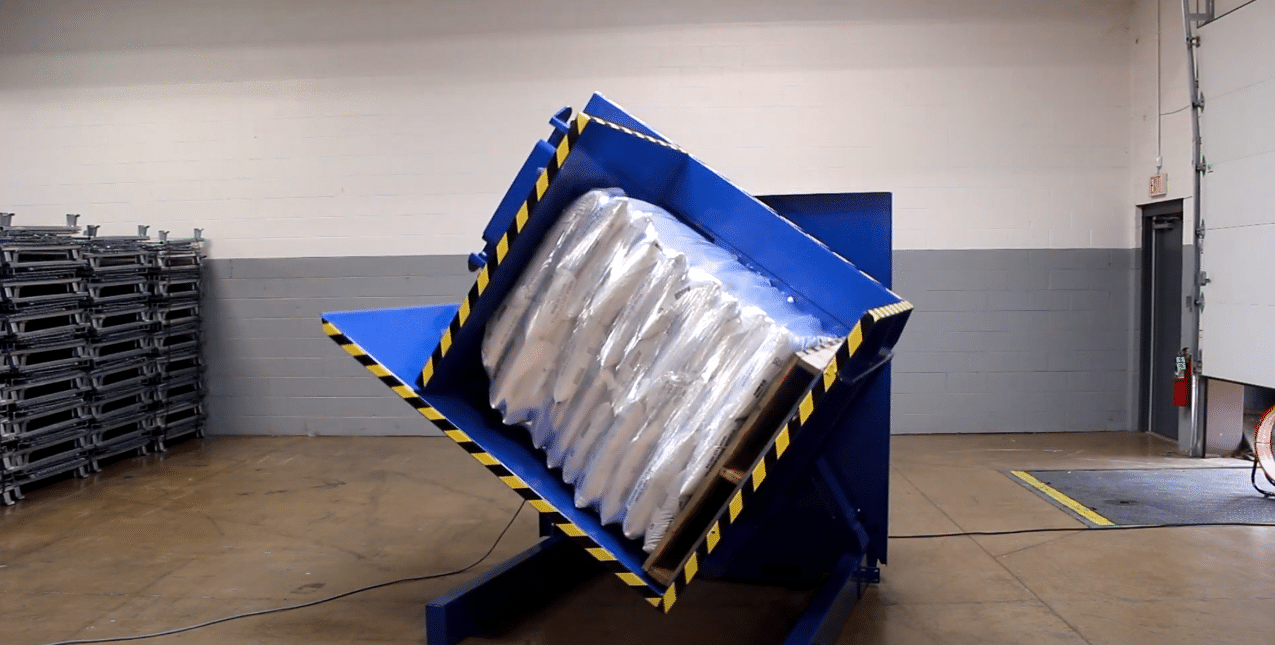Top Reasons United States Industries Choose Pallet Inverters for OSHA Compliance and Labor Cost Reduction
Are you constantly managing the risks and costs of manual labor in your warehouse or factory? You're not alone. Many US-based operations face the daily challenge of moving heavy loads, a process that is slow, expensive, and a major source of workplace injuries. These injuries don't just hurt your team; they lead to painful OSHA fines, soaring insurance premiums, and crippling downtime that stalls your entire production line. It feels like a problem with no easy solution, a constant drain on your resources and peace of mind. But there is a better way. Investing in a pallet inverter is a direct and powerful strategy to tackle these issues, transforming a point of weakness into a source of strength and efficiency.
The primary reasons United States industries choose pallet inverters are to drastically improve worker safety, ensure compliance with OSHA's strict material handling regulations, and achieve significant labor cost reductions. This is accomplished by automating the physically demanding and high-risk task of transferring goods from one pallet to another, which also minimizes product damage and boosts overall operational speed.

As an engineer who has spent his entire career in the packing machine industry, I've seen these challenges firsthand. I started on the factory floor and eventually built my own company, SHJLPACK. I understand the pressure to keep your people safe while also protecting your bottom line. It's a tough balance. That’s why I want to share my knowledge. A pallet inverter isn't just another piece of equipment. When chosen and used correctly, it’s a strategic tool that solves some of the most persistent problems in material handling. Let's dig deeper into how exactly this machine can deliver on its promise of a safer, more cost-effective operation for your business.
How Do Pallet Inverters Directly Improve OSHA Compliance?
Is the thought of an upcoming OSHA inspection a source of constant stress? You meticulously check your safety protocols, but you know that manual pallet handling is a weak link. A single incident, a back injury from an awkward lift, can lead to a serious citation, hefty fines, and a mark against your company's safety record. The pressure to prevent these musculoskeletal disorders (MSDs) is immense, as they represent one of the biggest risks in any industrial environment. The good news is that a pallet inverter system is designed specifically to engineer this risk out of your process, making compliance a natural outcome of a more efficient workflow.
Pallet inverters directly improve OSHA compliance by completely eliminating the need for manual stacking and unstacking of goods. This automation removes the dangerous bending, lifting, and twisting motions that are the leading causes of musculoskeletal disorders (MSDs), a key area of focus for OSHA's ergonomic safety guidelines. By mechanizing the load transfer process, you build safety directly into your operation.

Deeper Dive: Engineering Safety into Your Workflow
When I first started in this industry, I saw how physically draining it was for workers to transfer heavy bags or boxes from a broken pallet to a new one. They would bend, lift, and twist hundreds of times a day. This is a textbook recipe for injury. OSHA knows this, and their General Duty Clause, Section 5(a)(1), requires employers to provide a workplace free from recognized hazards that are causing or are likely to cause death or serious physical harm. Repetitive manual material handling is one of the most cited recognized hazards. A pallet inverter is not just a helpful tool; it is an engineered control that fundamentally removes the hazard. Instead of relying on training or personal protective equipment, you change the process itself, which is what OSHA prefers.
The Anatomy of an Unsafe Task
Let’s break down the risks of a manual transfer. A worker has to bend down to pick up a box from the bottom of a pallet, twist their body, and place it on a new pallet. Doing this once is no big deal. But doing it for an entire pallet load, multiple times a day, is incredibly stressful on the lower back, shoulders, and wrists. This leads to cumulative trauma disorders, also known as musculoskeletal disorders (MSDs). These injuries are costly, not just in terms of worker's compensation claims and higher insurance rates, but also in lost productivity and the cost of hiring and training replacements. A pallet inverter takes this entire dangerous sequence and replaces it with a simple, machine-controlled 180-degree rotation. The operator simply places the pallet in the machine and pushes a button.
| Hazard Category | Manual Pallet Transfer | Pallet Inverter Solution |
|---|---|---|
| Ergonomic Stress | Repetitive bending, lifting, twisting. High risk of back and shoulder injuries (MSDs). | Eliminates manual lifting. The machine does all the work. |
| Product Handling | Risk of dropping boxes, causing damage and creating trip hazards from spills. | Secures the load with hydraulic clamps before rotation, preventing drops. |
| Worker Fatigue | Physical exhaustion leads to reduced focus and a higher likelihood of mistakes and accidents. | The task is low-effort, allowing the operator to remain alert and focused on safety. |
| Compliance Risk | High potential for citations under OSHA's General Duty Clause and ergonomic standards. | Demonstrates a proactive engineering control to mitigate a recognized hazard. |
For leaders like Javier Morales, a steel mill owner I know, thinking in terms of risk mitigation is key. An investment in a pallet inverter isn't just an operational expense; it's a direct investment in de-risking his business from the financial and reputational damage of an OSHA violation.
What Is the Real Impact of Pallet Inverters on Labor Costs?
You look at your payroll every month and see labor costs creeping up. You have a team of good, hardworking people, but the task of manually transferring loads is slow and inefficient. You're essentially paying for hours of physically taxing work that adds very little value to your product. This time could be spent on more productive activities like quality control, inventory management, or operating other machinery. The inefficiency is a hidden cost that eats away at your profit margins every single day. Imagine reallocating those wages to roles that actively grow your business, instead of just maintaining a slow, manual process.
The real impact of a pallet inverter on labor costs is a dramatic reduction in the man-hours needed for load transfer tasks. A process that once required two or three employees for 20-30 minutes can be completed by a single operator in under two minutes. This directly translates to lower wage expenses, reduced overtime, and the ability to reassign valuable labor to more productive, value-adding activities.

Deeper Dive: Calculating the True Return on Investment
When I started my own factory, every dollar mattered. I had to justify every equipment purchase with a clear return on investment (ROI). A pallet inverter is one of the easiest machines to justify. Let's do some simple math. Suppose you have two workers spending a total of 4 hours per day just transferring loads from one pallet type to another (e.g., from wood to plastic for hygienic areas).
Let’s assume a conservative loaded labor rate of $25/hour per employee (including wages, taxes, and benefits).
- Manual Cost: 2 employees 4 hours/day $25/hour = $200 per day.
- Annual Manual Cost: $200/day * 250 working days/year = $50,000 per year.
Now, consider a pallet inverter. A single operator can perform the same work in about 30 minutes total throughout the day.
- Inverter Cost: 1 employee 0.5 hours/day $25/hour = $12.50 per day.
- Annual Inverter Cost: $12.50/day * 250 working days/year = $3,125 per year.
The direct labor savings are nearly $47,000 in the first year alone. For many US industries, a pallet inverter can pay for itself in well under 18 months on labor savings alone.
Beyond Direct Wages: The Hidden Costs
The calculation above doesn't even include the hidden costs that a pallet inverter helps you avoid. Think about it. Manual handling leads to more product damage. When a box is dropped, the product inside might be ruined. That's a direct loss. The process is also slower, creating bottlenecks at your shipping and receiving docks. A truck waiting an extra hour to be loaded or unloaded can lead to detention fees and strained relationships with logistics partners. These are real costs.
| Cost Factor | Manual Handling | Pallet Inverter | Financial Impact |
|---|---|---|---|
| Direct Labor | High (2-3 employees, long duration) | Low (1 employee, short duration) | Significant annual savings. |
| Product Damage | Higher risk of drops and impacts. | Very low risk; load is secured. | Reduced write-offs and waste. |
| Worker Turnover | High turnover in physically demanding jobs. | Easier job, higher employee retention. | Lower recruitment and training costs. |
| Workers' Comp | Higher risk of injury claims. | Drastically reduced risk. | Lower insurance premiums over time. |
| Throughput | Slow, creates bottlenecks. | Fast, increases dock efficiency. | Avoids detention fees, improves supply chain speed. |
When I talk to clients, I always tell them to look at the total cost of their current process, not just the wages. When you factor in everything, the financial case for a pallet inverter becomes undeniable. It's a key step in reducing the operational costs that leaders like Javier are always aiming to control.
Beyond Safety and Costs, What Other Operational Efficiencies Do Pallet Inverters Offer?
So, you've made your workplace safer and you're saving on labor. That's great. But your competitors are also getting smarter. You're still feeling the pressure to ship faster, handle more diverse orders, and maintain perfect product quality. A bottleneck in one area, like pallet exchange, can ripple through your entire operation, causing delays and frustrations. It's frustrating to know that a simple, solvable problem is holding back your facility's true potential. What if that same machine that solved your safety and labor issues could also unlock a new level of operational speed and flexibility?
Beyond safety and labor savings, pallet inverters provide critical operational efficiencies by dramatically increasing throughput speed, reducing product damage, and improving supply chain flexibility. They allow for the instant recovery of damaged goods, quick exchange to shipping or sanitized pallets, and streamlined management of rental pallet programs, making the entire warehouse more agile and responsive.

Deeper Dive: The Inverter as an Efficiency Hub
I like to think of a pallet inverter as the heart of an efficient warehouse dock. It's a central point that solves multiple logistical problems. For example, a truck arrives with a shipment, but one pallet is broken at the bottom of the stack. Manually, you would have to destack the entire pallet, piece by piece, just to replace the broken one. This could take 30 minutes and halt the entire receiving process. With a pallet inverter, you can clamp the load, rotate it, replace the broken pallet, and have it ready to go in less than two minutes. The bottleneck is gone.
Unlocking Supply Chain Agility
Modern supply chains demand flexibility. You may need to transfer goods from your standard wooden in-house pallets to plastic pallets for a cleanroom environment or to meet a specific customer's requirement. Or perhaps you use a rental pallet service like CHEP or PECO and need to transfer your finished goods onto these pallets for shipping. Doing this manually is slow and risks damaging the products right before they go out the door. A pallet inverter makes this a seamless, standardized process. This agility allows you to say "yes" to more customer requests and operate a more sophisticated internal logistics system. It helps you achieve the kind of high capacity utilization that factory owners are always targeting.
| Operational Challenge | Manual Solution (Slow, Risky) | Pallet Inverter Solution (Fast, Safe) | Impact on Goals |
|---|---|---|---|
| Damaged Pallet | Unstack entire load by hand. | Invert load, replace pallet in <2 mins. | Increases equipment uptime, reduces delays. |
| Required Pallet Type | Manually transfer goods to plastic/rental pallet. | Invert load onto the required pallet. | Enhances supply chain flexibility. |
| Damaged Goods | "Lost" goods at the bottom of a stack are hard to access. | Invert load for easy access to any layer. | Reduces product loss, improves quality control. |
| Load Straightening | Manually re-aligning a shifted load. | "Bump" and clamp the load in the inverter to square it up. | Improves storage density and transport safety. |
For a company that handles millions of tons of product, like Javier's steel mill, these small-time savings on each pallet add up to massive gains in overall plant efficiency and output. It's a classic example of how smart automation in one small area can have a huge positive impact on the entire system.
From My Experience, What Should You Consider Before Investing in a Pallet Inverter?
You're seeing the benefits. A pallet inverter looks like a smart move for your US-based operation. But now comes the hard part: choosing the right one. The market is full of options, from simple, no-frills models to complex, fully automated systems. Making the wrong choice is a costly mistake. You could end up with a machine that can't handle your product weight, is too slow for your throughput needs, or requires constant maintenance, completely wiping out your expected ROI. It's a decision that can feel overwhelming.
From my experience building and selling these machines, the most critical factors to consider before investing are your specific application's needs. You must analyze your load characteristics (weight, size, stability), your required cycle time and throughput, the physical layout of your facility, and the total cost of ownership, including installation, training, and maintenance support.

Deeper Dive: My Personal Checklist for a Smart Investment
When I transitioned from being an employee to owning my own factory, I learned that the success of any machine depends on the homework you do before you buy it. A great machine in the wrong application is a failed investment. I've built a simple framework to help my clients, and I want to share it with you. Think of this as a conversation between two engineers.
1. It's All About the Load
The single most important factor is the product you are handling. Don't start by looking at machines; start by looking at your pallet.
- Weight: What is your maximum load weight? Always choose a machine with a capacity at least 25% higher than your heaviest load to ensure longevity and safety.
- Dimensions: What are the length, width, and height of your typical pallet load? The machine's opening must accommodate your largest load.
- Stability: Is your product solid, like a crate of steel parts, or fragile and unstable, like a stack of open-top bags or bottles? This determines the type of clamping system you need. A machine with adjustable clamping pressure is essential for handling a variety of products without crushing them.
2. Match the Machine to Your Workflow
How will the machine fit into your operation?
- Loading Method: Will you be using a forklift or a pallet jack? A forklift can load a standard inverter, but a pallet jack requires a machine that can load from ground level.
- Throughput: How many pallets do you need to invert per hour? A standalone model is fine for a few pallets an hour, but if you need higher speeds, you should consider a semi-automated or fully-automated inline system.
- Footprint: Do you have space? Measure your available area carefully. Some models, like 180-degree inverters, have a smaller footprint than 90-degree tippers.
This is the kind of analysis that turns a supplier into a partner. It's not about selling a machine; it's about providing a total solution, which is the whole philosophy behind my company, SHJLPACK.
| Consideration Factor | Key Questions to Ask Yourself | My Recommendation (as an Engineer) |
|---|---|---|
| Load Type | Is it heavy? Fragile? Unstable? | Be honest about your worst-case load. Buy a machine that can handle that, not just your average load. |
| Facility Integration | How will I load it? Where will it go? | Draw a simple diagram of your workflow. See where the inverter fits. This will reveal if you need a ground-loading or forklift-loading model. |
| Level of Automation | Do I need to do 5 pallets an hour or 50? | Don't overbuy. A simple, robust standalone machine is often more reliable and cost-effective than a complex system you don't need. |
| Total Cost | What about shipping, installation, and parts? | Ask for the total cost of ownership. A cheap machine with expensive spare parts or poor support is not a bargain. |
Investing in a pallet inverter is a strategic decision. Taking the time to answer these questions will ensure you choose a machine that serves you well for years, helping you achieve your goals for safety, cost reduction, and efficiency.
Conclusion
A pallet inverter is a strategic investment in safety, efficiency, and profitability. Choosing the right partner and machine ensures these benefits will strengthen your operation for years to come.


